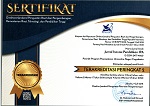The Meaning of Village Purification and Worshipping Water Spring as A Ritual To Preserve The Ecological Sustainability of Penanggungan Sites East Java, Indonesia
Abstract
This study attempted to describe the correlation between village purification and water spring worshipping – which are held every year by villagers nearby Penanggungan sites, as well as the sustainability of archaeological sites and their surrounding environment. Considering the research object was a cultural phenomenon, qualitative research was applied in describing and analyzing the finding. This research method demanded more detailed information of the sequent events, their components, and meanings. Therefore, we began the research activities by observing, describing, interpreting, and reporting every moment in the rituals. In the second stage, we attempted to correlate between this ritual proceed to the preservation of the water supply. Our research showed that ritual has played an important role in preserving the ecological balance between human beings and nature. When the people believed to the creed that temples and other archaeological objects were home to spiritual power and figured out the last civilization, they would not make any damages to the soil, illegal logging, and a fire in the ridge. Any disturbance to their mountain would give an effect on their means of life since most of the villagers were rice growers. It also proved that there was a connection between popular belief about the sacred place and environment conservation.
Keywords
Full Text:
PDFReferences
Anam, K. (2017). Tradisi Bersih Desa di Tamiajeng. Interview on Juny 2017.
Atmodjo, J. S. (1986). Punden Berundak di Gunung Penanggungann (Thesis). Jakarta: Universitas Indonesia.
Batoro, J. (2019). Perceptions of Sacred Site (Petren) and Plant Diversity in Malang, East Java, Indonesia. International Journal of Basic and Applied Sciences JBAS-IJENS, 19(6), 9-10.
Batoro, J. (2020). The Perception of Sacred Trees as Proponent of Water Spring in Malang Regency East Java. Indonesian Asian Journal of Medical and Biological Research, 6(3). 4-5.
Boomgaard, P. (2007). A World of Water: Rain, Rivers and Seas in Southeast Asian Histories. BRILL.
Brandes, J. L. A. (1913). Oud-Javaansche Oorkonden. Batavia: Albrecht & Co.
Douglas, M. (2001). Purity and Danger: An Analysis of the Concepts of Pollution and Taboo. London: Routledge.
Dove, M. R. (1985). The Agriecological Mythology of The Javanese and The Political Economy of Indonesia. Journal Indonesia, 39(8), 30-31.
Ferreira, T. C. (2018). Bridging Planned Conservation and Community Empowerment: Portuguese Case Studies. Journal of Cultural Heritage Management and Sustainable Development, 8(2), 179-193.
Hakam, A. (2017). Communal Feast Slametan: Belief System, Ritual and The Ideal of Javanesse Society. Jurnal Hayula. Journal of Multidisciplinary Islamic Studies, 1(1), 97-110.
Hudiyanto, R., & Lutfi, I. (2019). Toponimi Kota Malang. Jakarta: Direktorat Sejarah Direktorat Jenderal Kebudayaan Kementerian Pendidikan dan Kebudayaan.
Ibrahim, M. (1991). Laporan Kegiatan Penentuan Batas Wilayah Cagar Budaya dalam rangka Penyelamatan Situs Gunung Penanggungan dan Sekitarnya. Bakosurtanal dan Ditlinbinjarah LIPI.
Inglehart, R. & Baker W. E. (2000). Modernization, Cultural Change, and the Persistence of Traditional Values. Journal of the American Planning Association, 65(4), 412–423.
Izza, N. A. (2016). Karakteristik Bangunan Suci Bercorak Hindu-Buddha di Gunung Penanggunan dan Gunung Wajak: Sebuah Tinjauan Perbandingan Karakteristik. Jurnal Kapata Arkeologi, 12(1), 1-14.
Li, M. (2014). Cross-Cultural Tourist Research: A Meta-Analysis. Journal of Hospitality & Tourism Research, 38(1), 40-77.
Linton, R. (1936). The Study of Man. Appleton Century Crofts, Inc.
Munandar, A. A. (1990a). Arca dan Relief pada Kepurbakalaan Gunung Penanggungan Pembicaraan Ringkas Aspek Keagamaan. Jakarta: Fakultas Sastra UI, Monumen.
Munandar, A. A. (1990b). Kegiatan Keagamaan di Pawitra, Gunung Suci di Jawa Timur. Abad 14-15. Jakarta: Universitas Indonesia.
Pemerintah Desa Kedungngudi. (2007). Monografi Desa Kedungngudi.
Ratnawati, L. D. (2014). Warisan Budaya Tak Benda Penetapan Tahun 2014. Jakarta: Kemetrian Pendidikan dan Kebudayaan Direktorat Jendral Kebudayaan.
Salamun. (2015). Buku Sejarah Dusun Biting, Sempur, Balekambang dan Janjing. Mojokerto: Tidak diterbitkan.
Salazar, N. B. (2012). Community-Based Cultural Tourism: Issues, Threats and Opportunities. Journal of Sustainable Tourism, 20(1), 9-12.
Sidomulya, H. (2013). Mengenal Situs Purbakala di Gunung Penanggungan. Surabaya: UBAYA Press.
Silberberg, T. (1995). Cultural Tourism and Business Opportunities for Museums and Heritage Sites. Journal Tourism Management, 16(5), 361-372.
Singh, S., Timothy, D. J., & Dowling, R. K. (2003). Tourism in Destination Communities. USA: CABI Publishing.
Raharjo, S. (2013). Beberapa Permasalahan Pelestarian Kawasan Cagar Budaya dan Stratagi Solusinya. Jurnal Konservasi Cagar Budaya, 7(2), 4-17.
Republik Indonesia. (2010). Undang Undang Nomor 11 Tahun 2010 tentang Cagar Budaya. Lembaran Negara Republik Indonesia Tahun 2010 Nomor 5.
Woodley, E. (1991). Indigenous Ecological Knowledge Systems and Development. Journal of Agriculture and Human Values, 8(1), 174-185.
DOI: http://dx.doi.org/10.17977/um019v5i2p376-388
Refbacks
- There are currently no refbacks.
Copyright (c) 2020 Jurnal Ilmiah Pendidikan Pancasila dan Kewarganegaraan

This work is licensed under a Creative Commons Attribution 4.0 International License.
View My Stats










